HOS803 - Contemporary Issues Affecting Sustainable Tourism Dev.
VerifiedAdded on 2023/03/30
|9
|2668
|189
Literature Review
AI Summary
This literature review examines the contemporary issues affecting sustainable tourism development and their impact on stakeholders and management approaches. It explores the concept of sustainable tourism, emphasizing its aim to balance environmental protection, cultural diversity, and customer experience. The review delves into key elements such as transportation, water usage, land management, and the impact on local livelihoods. It highlights the negative effects of tourism activities, including CO2 emissions from travel, water contamination from hotels and adventure sports, and the strain on local resources. The review underscores the importance of sustainable practices in mitigating these issues and ensuring the well-being of local communities and the environment.
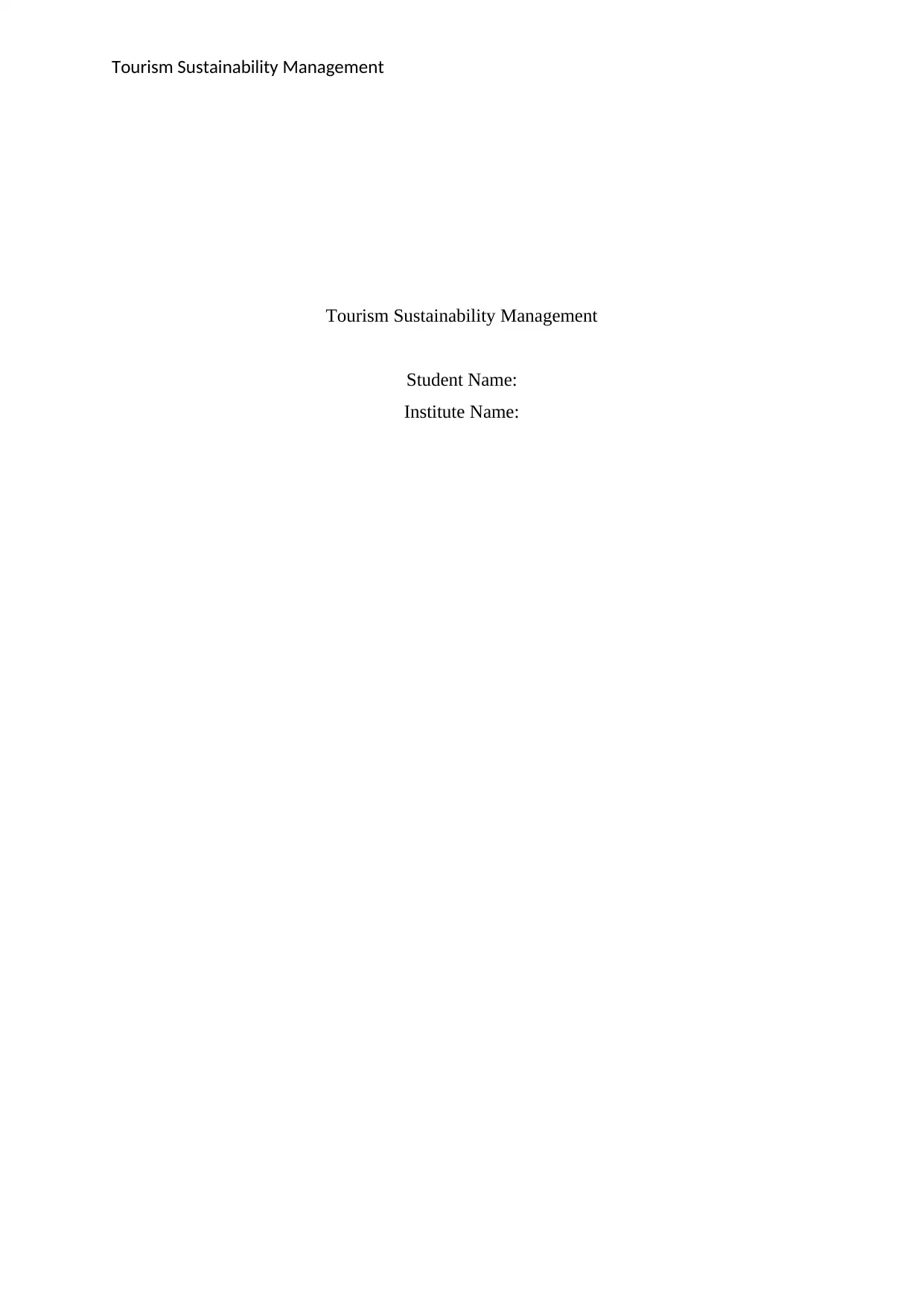
Tourism Sustainability Management
Tourism Sustainability Management
Student Name:
Institute Name:
Tourism Sustainability Management
Student Name:
Institute Name:
Paraphrase This Document
Need a fresh take? Get an instant paraphrase of this document with our AI Paraphraser
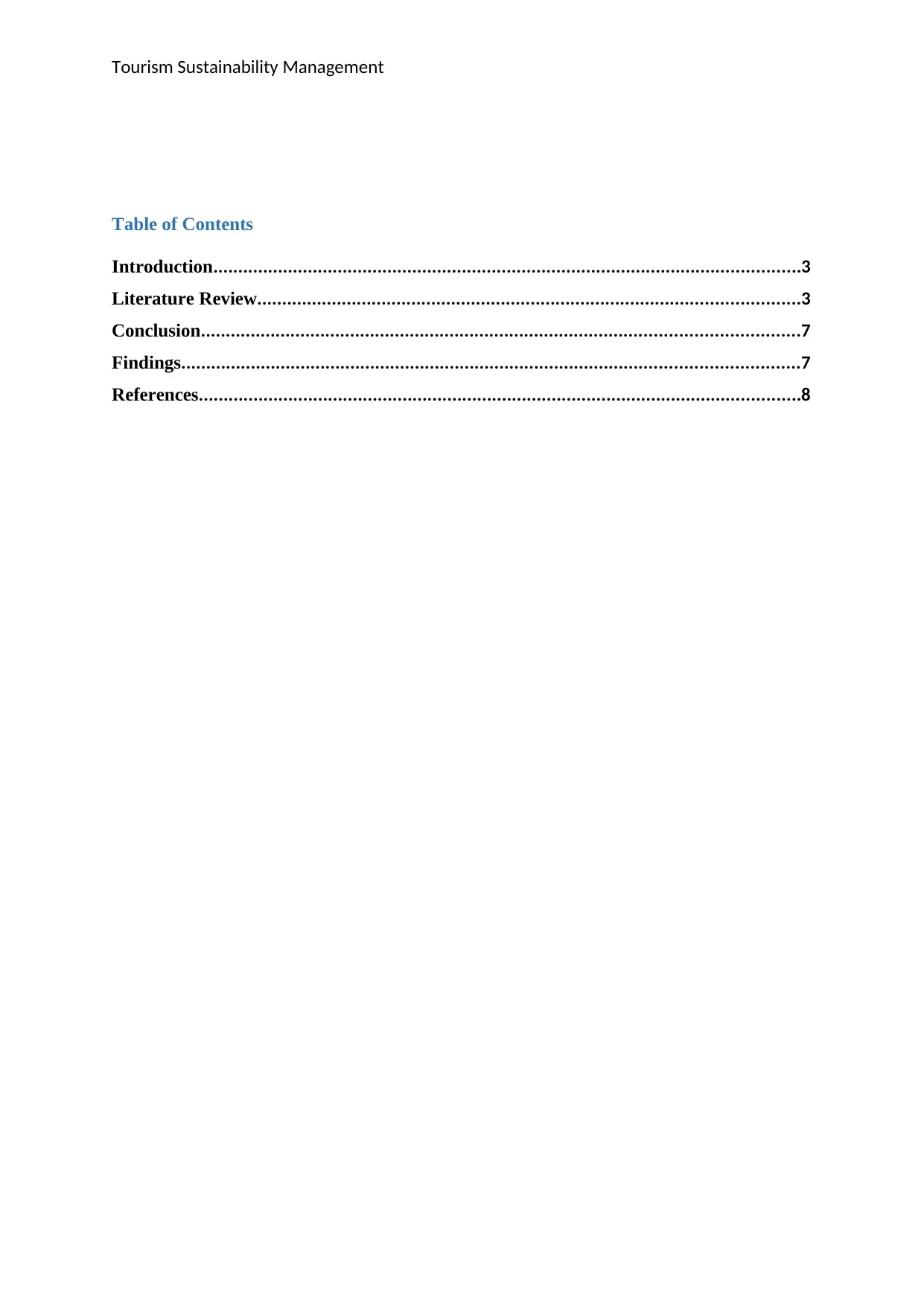
Tourism Sustainability Management
Table of Contents
Introduction......................................................................................................................3
Literature Review.............................................................................................................3
Conclusion........................................................................................................................7
Findings............................................................................................................................7
References.........................................................................................................................8
Table of Contents
Introduction......................................................................................................................3
Literature Review.............................................................................................................3
Conclusion........................................................................................................................7
Findings............................................................................................................................7
References.........................................................................................................................8
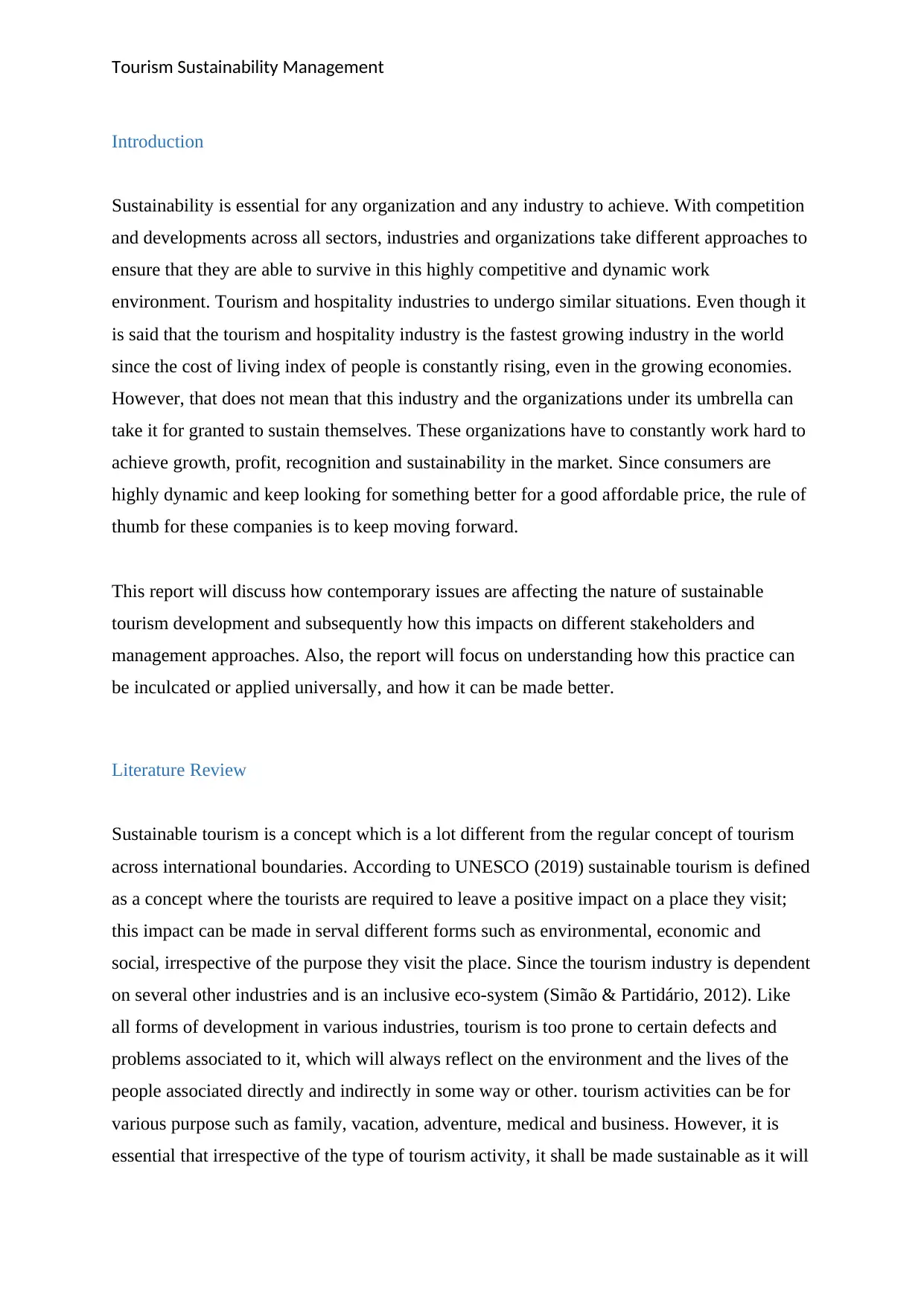
Tourism Sustainability Management
Introduction
Sustainability is essential for any organization and any industry to achieve. With competition
and developments across all sectors, industries and organizations take different approaches to
ensure that they are able to survive in this highly competitive and dynamic work
environment. Tourism and hospitality industries to undergo similar situations. Even though it
is said that the tourism and hospitality industry is the fastest growing industry in the world
since the cost of living index of people is constantly rising, even in the growing economies.
However, that does not mean that this industry and the organizations under its umbrella can
take it for granted to sustain themselves. These organizations have to constantly work hard to
achieve growth, profit, recognition and sustainability in the market. Since consumers are
highly dynamic and keep looking for something better for a good affordable price, the rule of
thumb for these companies is to keep moving forward.
This report will discuss how contemporary issues are affecting the nature of sustainable
tourism development and subsequently how this impacts on different stakeholders and
management approaches. Also, the report will focus on understanding how this practice can
be inculcated or applied universally, and how it can be made better.
Literature Review
Sustainable tourism is a concept which is a lot different from the regular concept of tourism
across international boundaries. According to UNESCO (2019) sustainable tourism is defined
as a concept where the tourists are required to leave a positive impact on a place they visit;
this impact can be made in serval different forms such as environmental, economic and
social, irrespective of the purpose they visit the place. Since the tourism industry is dependent
on several other industries and is an inclusive eco-system (Simão & Partidário, 2012) . Like
all forms of development in various industries, tourism is too prone to certain defects and
problems associated to it, which will always reflect on the environment and the lives of the
people associated directly and indirectly in some way or other. tourism activities can be for
various purpose such as family, vacation, adventure, medical and business. However, it is
essential that irrespective of the type of tourism activity, it shall be made sustainable as it will
Introduction
Sustainability is essential for any organization and any industry to achieve. With competition
and developments across all sectors, industries and organizations take different approaches to
ensure that they are able to survive in this highly competitive and dynamic work
environment. Tourism and hospitality industries to undergo similar situations. Even though it
is said that the tourism and hospitality industry is the fastest growing industry in the world
since the cost of living index of people is constantly rising, even in the growing economies.
However, that does not mean that this industry and the organizations under its umbrella can
take it for granted to sustain themselves. These organizations have to constantly work hard to
achieve growth, profit, recognition and sustainability in the market. Since consumers are
highly dynamic and keep looking for something better for a good affordable price, the rule of
thumb for these companies is to keep moving forward.
This report will discuss how contemporary issues are affecting the nature of sustainable
tourism development and subsequently how this impacts on different stakeholders and
management approaches. Also, the report will focus on understanding how this practice can
be inculcated or applied universally, and how it can be made better.
Literature Review
Sustainable tourism is a concept which is a lot different from the regular concept of tourism
across international boundaries. According to UNESCO (2019) sustainable tourism is defined
as a concept where the tourists are required to leave a positive impact on a place they visit;
this impact can be made in serval different forms such as environmental, economic and
social, irrespective of the purpose they visit the place. Since the tourism industry is dependent
on several other industries and is an inclusive eco-system (Simão & Partidário, 2012) . Like
all forms of development in various industries, tourism is too prone to certain defects and
problems associated to it, which will always reflect on the environment and the lives of the
people associated directly and indirectly in some way or other. tourism activities can be for
various purpose such as family, vacation, adventure, medical and business. However, it is
essential that irrespective of the type of tourism activity, it shall be made sustainable as it will
⊘ This is a preview!⊘
Do you want full access?
Subscribe today to unlock all pages.

Trusted by 1+ million students worldwide
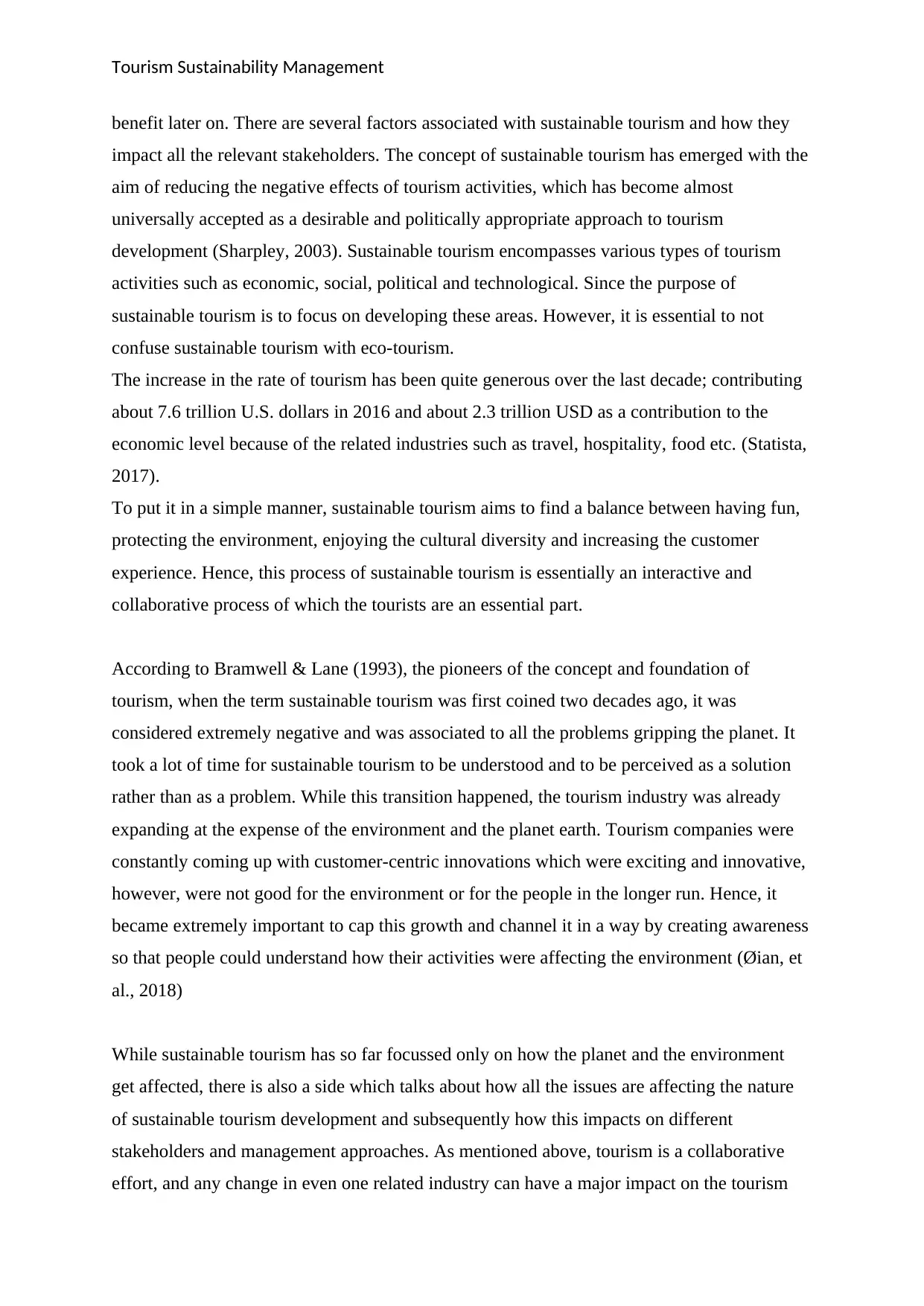
Tourism Sustainability Management
benefit later on. There are several factors associated with sustainable tourism and how they
impact all the relevant stakeholders. The concept of sustainable tourism has emerged with the
aim of reducing the negative effects of tourism activities, which has become almost
universally accepted as a desirable and politically appropriate approach to tourism
development (Sharpley, 2003). Sustainable tourism encompasses various types of tourism
activities such as economic, social, political and technological. Since the purpose of
sustainable tourism is to focus on developing these areas. However, it is essential to not
confuse sustainable tourism with eco-tourism.
The increase in the rate of tourism has been quite generous over the last decade; contributing
about 7.6 trillion U.S. dollars in 2016 and about 2.3 trillion USD as a contribution to the
economic level because of the related industries such as travel, hospitality, food etc. (Statista,
2017).
To put it in a simple manner, sustainable tourism aims to find a balance between having fun,
protecting the environment, enjoying the cultural diversity and increasing the customer
experience. Hence, this process of sustainable tourism is essentially an interactive and
collaborative process of which the tourists are an essential part.
According to Bramwell & Lane (1993), the pioneers of the concept and foundation of
tourism, when the term sustainable tourism was first coined two decades ago, it was
considered extremely negative and was associated to all the problems gripping the planet. It
took a lot of time for sustainable tourism to be understood and to be perceived as a solution
rather than as a problem. While this transition happened, the tourism industry was already
expanding at the expense of the environment and the planet earth. Tourism companies were
constantly coming up with customer-centric innovations which were exciting and innovative,
however, were not good for the environment or for the people in the longer run. Hence, it
became extremely important to cap this growth and channel it in a way by creating awareness
so that people could understand how their activities were affecting the environment (Øian, et
al., 2018)
While sustainable tourism has so far focussed only on how the planet and the environment
get affected, there is also a side which talks about how all the issues are affecting the nature
of sustainable tourism development and subsequently how this impacts on different
stakeholders and management approaches. As mentioned above, tourism is a collaborative
effort, and any change in even one related industry can have a major impact on the tourism
benefit later on. There are several factors associated with sustainable tourism and how they
impact all the relevant stakeholders. The concept of sustainable tourism has emerged with the
aim of reducing the negative effects of tourism activities, which has become almost
universally accepted as a desirable and politically appropriate approach to tourism
development (Sharpley, 2003). Sustainable tourism encompasses various types of tourism
activities such as economic, social, political and technological. Since the purpose of
sustainable tourism is to focus on developing these areas. However, it is essential to not
confuse sustainable tourism with eco-tourism.
The increase in the rate of tourism has been quite generous over the last decade; contributing
about 7.6 trillion U.S. dollars in 2016 and about 2.3 trillion USD as a contribution to the
economic level because of the related industries such as travel, hospitality, food etc. (Statista,
2017).
To put it in a simple manner, sustainable tourism aims to find a balance between having fun,
protecting the environment, enjoying the cultural diversity and increasing the customer
experience. Hence, this process of sustainable tourism is essentially an interactive and
collaborative process of which the tourists are an essential part.
According to Bramwell & Lane (1993), the pioneers of the concept and foundation of
tourism, when the term sustainable tourism was first coined two decades ago, it was
considered extremely negative and was associated to all the problems gripping the planet. It
took a lot of time for sustainable tourism to be understood and to be perceived as a solution
rather than as a problem. While this transition happened, the tourism industry was already
expanding at the expense of the environment and the planet earth. Tourism companies were
constantly coming up with customer-centric innovations which were exciting and innovative,
however, were not good for the environment or for the people in the longer run. Hence, it
became extremely important to cap this growth and channel it in a way by creating awareness
so that people could understand how their activities were affecting the environment (Øian, et
al., 2018)
While sustainable tourism has so far focussed only on how the planet and the environment
get affected, there is also a side which talks about how all the issues are affecting the nature
of sustainable tourism development and subsequently how this impacts on different
stakeholders and management approaches. As mentioned above, tourism is a collaborative
effort, and any change in even one related industry can have a major impact on the tourism
Paraphrase This Document
Need a fresh take? Get an instant paraphrase of this document with our AI Paraphraser
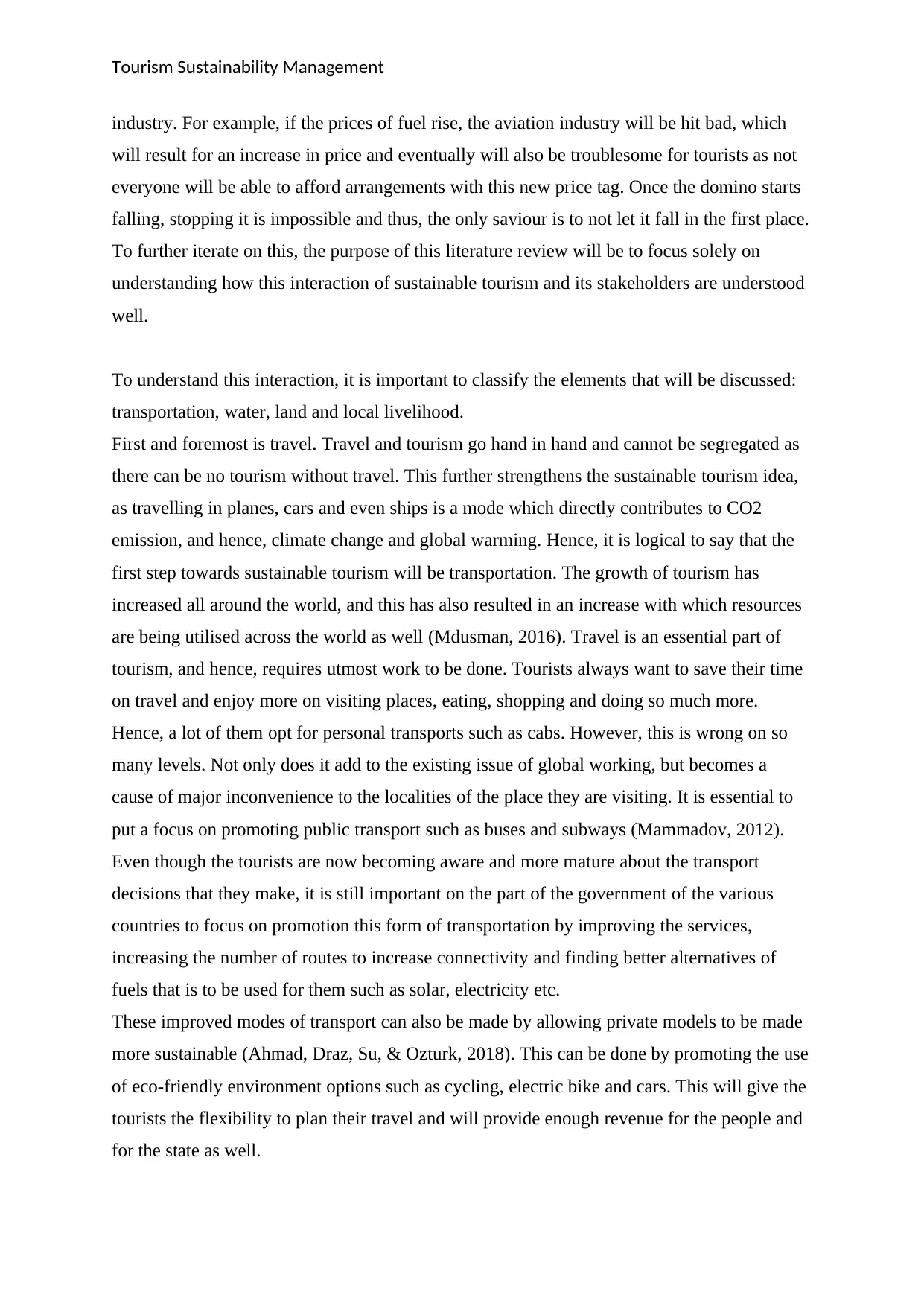
Tourism Sustainability Management
industry. For example, if the prices of fuel rise, the aviation industry will be hit bad, which
will result for an increase in price and eventually will also be troublesome for tourists as not
everyone will be able to afford arrangements with this new price tag. Once the domino starts
falling, stopping it is impossible and thus, the only saviour is to not let it fall in the first place.
To further iterate on this, the purpose of this literature review will be to focus solely on
understanding how this interaction of sustainable tourism and its stakeholders are understood
well.
To understand this interaction, it is important to classify the elements that will be discussed:
transportation, water, land and local livelihood.
First and foremost is travel. Travel and tourism go hand in hand and cannot be segregated as
there can be no tourism without travel. This further strengthens the sustainable tourism idea,
as travelling in planes, cars and even ships is a mode which directly contributes to CO2
emission, and hence, climate change and global warming. Hence, it is logical to say that the
first step towards sustainable tourism will be transportation. The growth of tourism has
increased all around the world, and this has also resulted in an increase with which resources
are being utilised across the world as well (Mdusman, 2016). Travel is an essential part of
tourism, and hence, requires utmost work to be done. Tourists always want to save their time
on travel and enjoy more on visiting places, eating, shopping and doing so much more.
Hence, a lot of them opt for personal transports such as cabs. However, this is wrong on so
many levels. Not only does it add to the existing issue of global working, but becomes a
cause of major inconvenience to the localities of the place they are visiting. It is essential to
put a focus on promoting public transport such as buses and subways (Mammadov, 2012).
Even though the tourists are now becoming aware and more mature about the transport
decisions that they make, it is still important on the part of the government of the various
countries to focus on promotion this form of transportation by improving the services,
increasing the number of routes to increase connectivity and finding better alternatives of
fuels that is to be used for them such as solar, electricity etc.
These improved modes of transport can also be made by allowing private models to be made
more sustainable (Ahmad, Draz, Su, & Ozturk, 2018). This can be done by promoting the use
of eco-friendly environment options such as cycling, electric bike and cars. This will give the
tourists the flexibility to plan their travel and will provide enough revenue for the people and
for the state as well.
industry. For example, if the prices of fuel rise, the aviation industry will be hit bad, which
will result for an increase in price and eventually will also be troublesome for tourists as not
everyone will be able to afford arrangements with this new price tag. Once the domino starts
falling, stopping it is impossible and thus, the only saviour is to not let it fall in the first place.
To further iterate on this, the purpose of this literature review will be to focus solely on
understanding how this interaction of sustainable tourism and its stakeholders are understood
well.
To understand this interaction, it is important to classify the elements that will be discussed:
transportation, water, land and local livelihood.
First and foremost is travel. Travel and tourism go hand in hand and cannot be segregated as
there can be no tourism without travel. This further strengthens the sustainable tourism idea,
as travelling in planes, cars and even ships is a mode which directly contributes to CO2
emission, and hence, climate change and global warming. Hence, it is logical to say that the
first step towards sustainable tourism will be transportation. The growth of tourism has
increased all around the world, and this has also resulted in an increase with which resources
are being utilised across the world as well (Mdusman, 2016). Travel is an essential part of
tourism, and hence, requires utmost work to be done. Tourists always want to save their time
on travel and enjoy more on visiting places, eating, shopping and doing so much more.
Hence, a lot of them opt for personal transports such as cabs. However, this is wrong on so
many levels. Not only does it add to the existing issue of global working, but becomes a
cause of major inconvenience to the localities of the place they are visiting. It is essential to
put a focus on promoting public transport such as buses and subways (Mammadov, 2012).
Even though the tourists are now becoming aware and more mature about the transport
decisions that they make, it is still important on the part of the government of the various
countries to focus on promotion this form of transportation by improving the services,
increasing the number of routes to increase connectivity and finding better alternatives of
fuels that is to be used for them such as solar, electricity etc.
These improved modes of transport can also be made by allowing private models to be made
more sustainable (Ahmad, Draz, Su, & Ozturk, 2018). This can be done by promoting the use
of eco-friendly environment options such as cycling, electric bike and cars. This will give the
tourists the flexibility to plan their travel and will provide enough revenue for the people and
for the state as well.
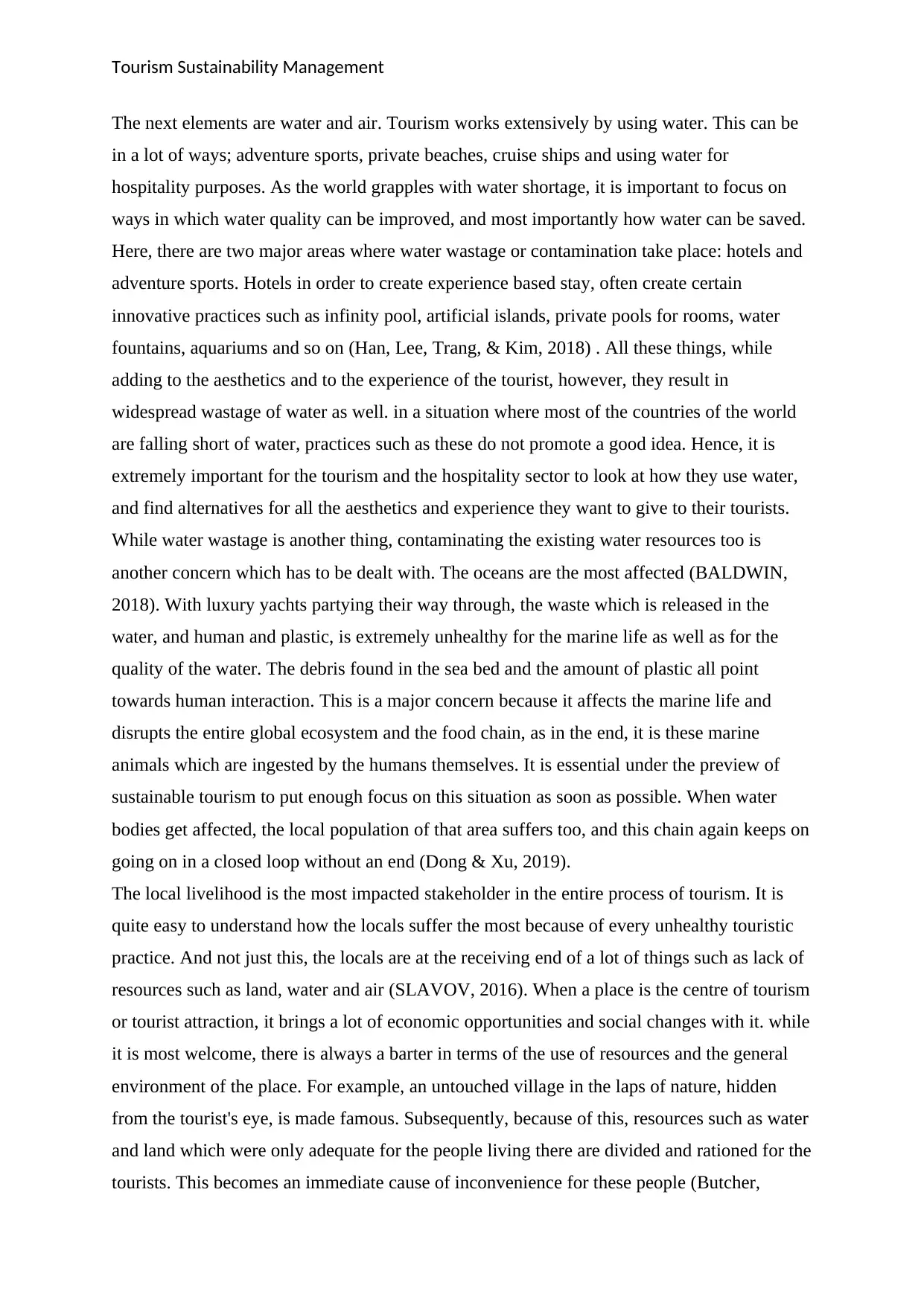
Tourism Sustainability Management
The next elements are water and air. Tourism works extensively by using water. This can be
in a lot of ways; adventure sports, private beaches, cruise ships and using water for
hospitality purposes. As the world grapples with water shortage, it is important to focus on
ways in which water quality can be improved, and most importantly how water can be saved.
Here, there are two major areas where water wastage or contamination take place: hotels and
adventure sports. Hotels in order to create experience based stay, often create certain
innovative practices such as infinity pool, artificial islands, private pools for rooms, water
fountains, aquariums and so on (Han, Lee, Trang, & Kim, 2018) . All these things, while
adding to the aesthetics and to the experience of the tourist, however, they result in
widespread wastage of water as well. in a situation where most of the countries of the world
are falling short of water, practices such as these do not promote a good idea. Hence, it is
extremely important for the tourism and the hospitality sector to look at how they use water,
and find alternatives for all the aesthetics and experience they want to give to their tourists.
While water wastage is another thing, contaminating the existing water resources too is
another concern which has to be dealt with. The oceans are the most affected (BALDWIN,
2018). With luxury yachts partying their way through, the waste which is released in the
water, and human and plastic, is extremely unhealthy for the marine life as well as for the
quality of the water. The debris found in the sea bed and the amount of plastic all point
towards human interaction. This is a major concern because it affects the marine life and
disrupts the entire global ecosystem and the food chain, as in the end, it is these marine
animals which are ingested by the humans themselves. It is essential under the preview of
sustainable tourism to put enough focus on this situation as soon as possible. When water
bodies get affected, the local population of that area suffers too, and this chain again keeps on
going on in a closed loop without an end (Dong & Xu, 2019).
The local livelihood is the most impacted stakeholder in the entire process of tourism. It is
quite easy to understand how the locals suffer the most because of every unhealthy touristic
practice. And not just this, the locals are at the receiving end of a lot of things such as lack of
resources such as land, water and air (SLAVOV, 2016). When a place is the centre of tourism
or tourist attraction, it brings a lot of economic opportunities and social changes with it. while
it is most welcome, there is always a barter in terms of the use of resources and the general
environment of the place. For example, an untouched village in the laps of nature, hidden
from the tourist's eye, is made famous. Subsequently, because of this, resources such as water
and land which were only adequate for the people living there are divided and rationed for the
tourists. This becomes an immediate cause of inconvenience for these people (Butcher,
The next elements are water and air. Tourism works extensively by using water. This can be
in a lot of ways; adventure sports, private beaches, cruise ships and using water for
hospitality purposes. As the world grapples with water shortage, it is important to focus on
ways in which water quality can be improved, and most importantly how water can be saved.
Here, there are two major areas where water wastage or contamination take place: hotels and
adventure sports. Hotels in order to create experience based stay, often create certain
innovative practices such as infinity pool, artificial islands, private pools for rooms, water
fountains, aquariums and so on (Han, Lee, Trang, & Kim, 2018) . All these things, while
adding to the aesthetics and to the experience of the tourist, however, they result in
widespread wastage of water as well. in a situation where most of the countries of the world
are falling short of water, practices such as these do not promote a good idea. Hence, it is
extremely important for the tourism and the hospitality sector to look at how they use water,
and find alternatives for all the aesthetics and experience they want to give to their tourists.
While water wastage is another thing, contaminating the existing water resources too is
another concern which has to be dealt with. The oceans are the most affected (BALDWIN,
2018). With luxury yachts partying their way through, the waste which is released in the
water, and human and plastic, is extremely unhealthy for the marine life as well as for the
quality of the water. The debris found in the sea bed and the amount of plastic all point
towards human interaction. This is a major concern because it affects the marine life and
disrupts the entire global ecosystem and the food chain, as in the end, it is these marine
animals which are ingested by the humans themselves. It is essential under the preview of
sustainable tourism to put enough focus on this situation as soon as possible. When water
bodies get affected, the local population of that area suffers too, and this chain again keeps on
going on in a closed loop without an end (Dong & Xu, 2019).
The local livelihood is the most impacted stakeholder in the entire process of tourism. It is
quite easy to understand how the locals suffer the most because of every unhealthy touristic
practice. And not just this, the locals are at the receiving end of a lot of things such as lack of
resources such as land, water and air (SLAVOV, 2016). When a place is the centre of tourism
or tourist attraction, it brings a lot of economic opportunities and social changes with it. while
it is most welcome, there is always a barter in terms of the use of resources and the general
environment of the place. For example, an untouched village in the laps of nature, hidden
from the tourist's eye, is made famous. Subsequently, because of this, resources such as water
and land which were only adequate for the people living there are divided and rationed for the
tourists. This becomes an immediate cause of inconvenience for these people (Butcher,
⊘ This is a preview!⊘
Do you want full access?
Subscribe today to unlock all pages.

Trusted by 1+ million students worldwide
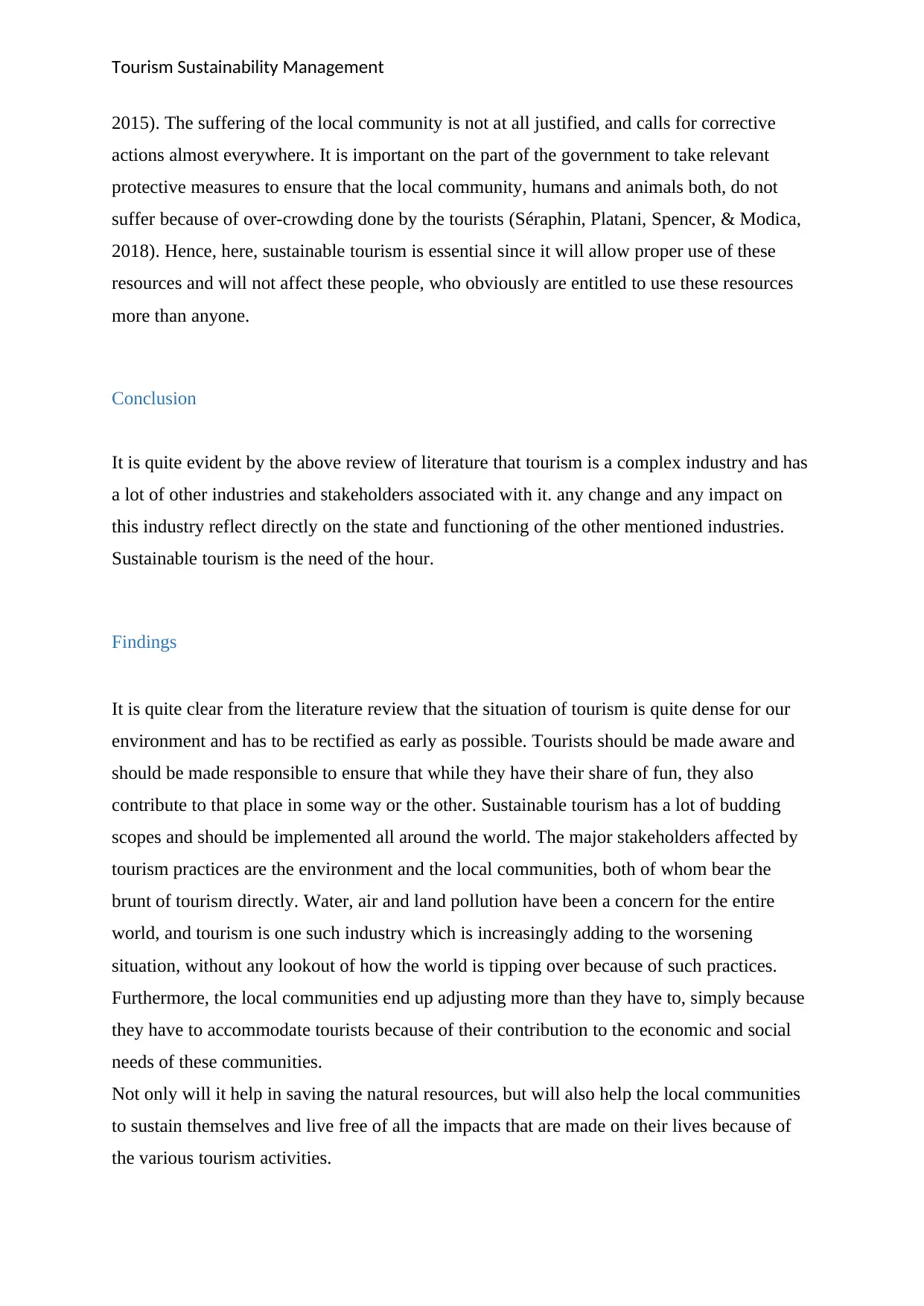
Tourism Sustainability Management
2015). The suffering of the local community is not at all justified, and calls for corrective
actions almost everywhere. It is important on the part of the government to take relevant
protective measures to ensure that the local community, humans and animals both, do not
suffer because of over-crowding done by the tourists (Séraphin, Platani, Spencer, & Modica,
2018). Hence, here, sustainable tourism is essential since it will allow proper use of these
resources and will not affect these people, who obviously are entitled to use these resources
more than anyone.
Conclusion
It is quite evident by the above review of literature that tourism is a complex industry and has
a lot of other industries and stakeholders associated with it. any change and any impact on
this industry reflect directly on the state and functioning of the other mentioned industries.
Sustainable tourism is the need of the hour.
Findings
It is quite clear from the literature review that the situation of tourism is quite dense for our
environment and has to be rectified as early as possible. Tourists should be made aware and
should be made responsible to ensure that while they have their share of fun, they also
contribute to that place in some way or the other. Sustainable tourism has a lot of budding
scopes and should be implemented all around the world. The major stakeholders affected by
tourism practices are the environment and the local communities, both of whom bear the
brunt of tourism directly. Water, air and land pollution have been a concern for the entire
world, and tourism is one such industry which is increasingly adding to the worsening
situation, without any lookout of how the world is tipping over because of such practices.
Furthermore, the local communities end up adjusting more than they have to, simply because
they have to accommodate tourists because of their contribution to the economic and social
needs of these communities.
Not only will it help in saving the natural resources, but will also help the local communities
to sustain themselves and live free of all the impacts that are made on their lives because of
the various tourism activities.
2015). The suffering of the local community is not at all justified, and calls for corrective
actions almost everywhere. It is important on the part of the government to take relevant
protective measures to ensure that the local community, humans and animals both, do not
suffer because of over-crowding done by the tourists (Séraphin, Platani, Spencer, & Modica,
2018). Hence, here, sustainable tourism is essential since it will allow proper use of these
resources and will not affect these people, who obviously are entitled to use these resources
more than anyone.
Conclusion
It is quite evident by the above review of literature that tourism is a complex industry and has
a lot of other industries and stakeholders associated with it. any change and any impact on
this industry reflect directly on the state and functioning of the other mentioned industries.
Sustainable tourism is the need of the hour.
Findings
It is quite clear from the literature review that the situation of tourism is quite dense for our
environment and has to be rectified as early as possible. Tourists should be made aware and
should be made responsible to ensure that while they have their share of fun, they also
contribute to that place in some way or the other. Sustainable tourism has a lot of budding
scopes and should be implemented all around the world. The major stakeholders affected by
tourism practices are the environment and the local communities, both of whom bear the
brunt of tourism directly. Water, air and land pollution have been a concern for the entire
world, and tourism is one such industry which is increasingly adding to the worsening
situation, without any lookout of how the world is tipping over because of such practices.
Furthermore, the local communities end up adjusting more than they have to, simply because
they have to accommodate tourists because of their contribution to the economic and social
needs of these communities.
Not only will it help in saving the natural resources, but will also help the local communities
to sustain themselves and live free of all the impacts that are made on their lives because of
the various tourism activities.
Paraphrase This Document
Need a fresh take? Get an instant paraphrase of this document with our AI Paraphraser
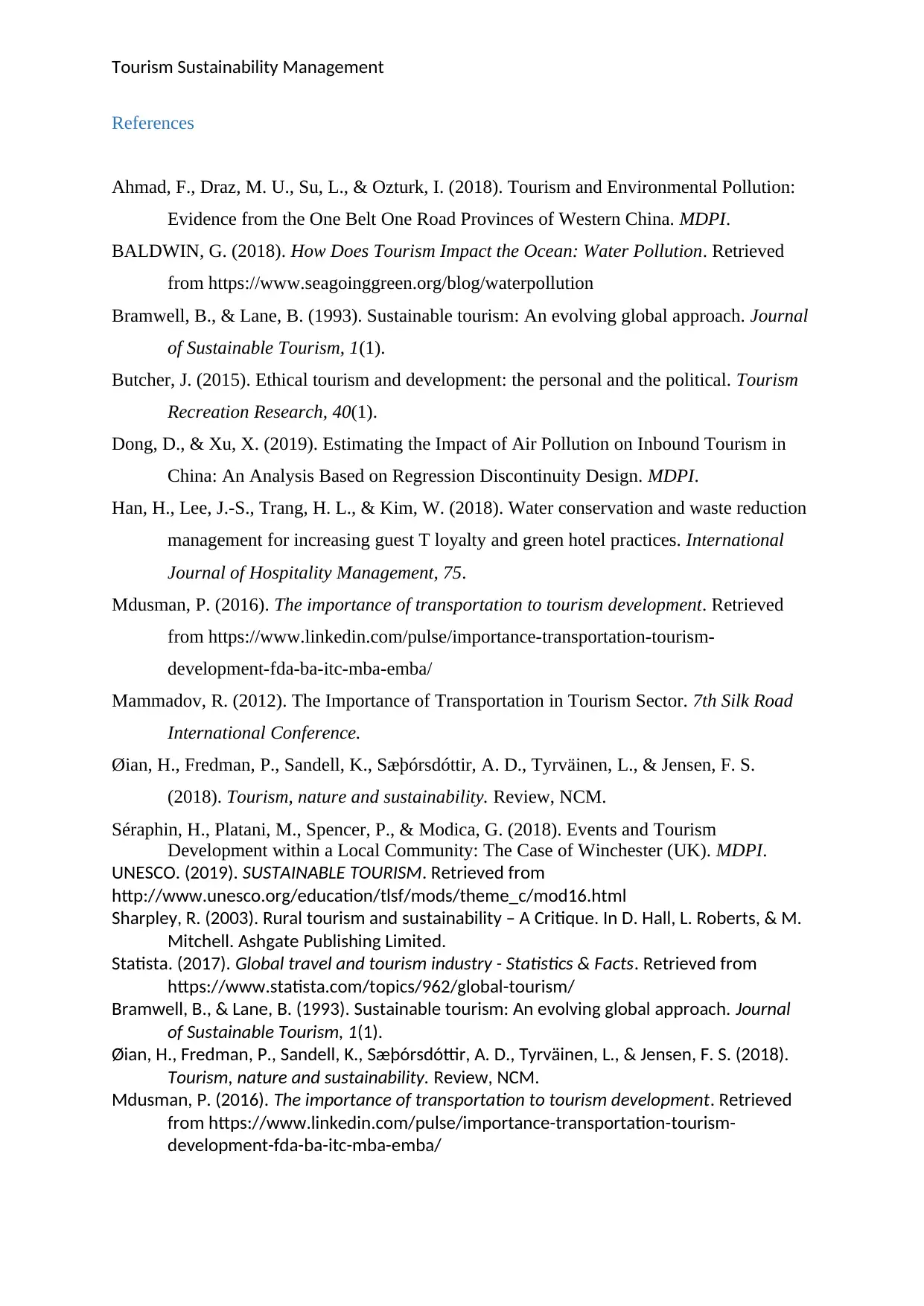
Tourism Sustainability Management
References
Ahmad, F., Draz, M. U., Su, L., & Ozturk, I. (2018). Tourism and Environmental Pollution:
Evidence from the One Belt One Road Provinces of Western China. MDPI.
BALDWIN, G. (2018). How Does Tourism Impact the Ocean: Water Pollution. Retrieved
from https://www.seagoinggreen.org/blog/waterpollution
Bramwell, B., & Lane, B. (1993). Sustainable tourism: An evolving global approach. Journal
of Sustainable Tourism, 1(1).
Butcher, J. (2015). Ethical tourism and development: the personal and the political. Tourism
Recreation Research, 40(1).
Dong, D., & Xu, X. (2019). Estimating the Impact of Air Pollution on Inbound Tourism in
China: An Analysis Based on Regression Discontinuity Design. MDPI.
Han, H., Lee, J.-S., Trang, H. L., & Kim, W. (2018). Water conservation and waste reduction
management for increasing guest T loyalty and green hotel practices. International
Journal of Hospitality Management, 75.
Mdusman, P. (2016). The importance of transportation to tourism development. Retrieved
from https://www.linkedin.com/pulse/importance-transportation-tourism-
development-fda-ba-itc-mba-emba/
Mammadov, R. (2012). The Importance of Transportation in Tourism Sector. 7th Silk Road
International Conference.
Øian, H., Fredman, P., Sandell, K., Sæþórsdóttir, A. D., Tyrväinen, L., & Jensen, F. S.
(2018). Tourism, nature and sustainability. Review, NCM.
Séraphin, H., Platani, M., Spencer, P., & Modica, G. (2018). Events and Tourism
Development within a Local Community: The Case of Winchester (UK). MDPI.
UNESCO. (2019). SUSTAINABLE TOURISM. Retrieved from
http://www.unesco.org/education/tlsf/mods/theme_c/mod16.html
Sharpley, R. (2003). Rural tourism and sustainability – A Critique. In D. Hall, L. Roberts, & M.
Mitchell. Ashgate Publishing Limited.
Statista. (2017). Global travel and tourism industry - Statistics & Facts. Retrieved from
https://www.statista.com/topics/962/global-tourism/
Bramwell, B., & Lane, B. (1993). Sustainable tourism: An evolving global approach. Journal
of Sustainable Tourism, 1(1).
Øian, H., Fredman, P., Sandell, K., Sæþórsdóttir, A. D., Tyrväinen, L., & Jensen, F. S. (2018).
Tourism, nature and sustainability. Review, NCM.
Mdusman, P. (2016). The importance of transportation to tourism development. Retrieved
from https://www.linkedin.com/pulse/importance-transportation-tourism-
development-fda-ba-itc-mba-emba/
References
Ahmad, F., Draz, M. U., Su, L., & Ozturk, I. (2018). Tourism and Environmental Pollution:
Evidence from the One Belt One Road Provinces of Western China. MDPI.
BALDWIN, G. (2018). How Does Tourism Impact the Ocean: Water Pollution. Retrieved
from https://www.seagoinggreen.org/blog/waterpollution
Bramwell, B., & Lane, B. (1993). Sustainable tourism: An evolving global approach. Journal
of Sustainable Tourism, 1(1).
Butcher, J. (2015). Ethical tourism and development: the personal and the political. Tourism
Recreation Research, 40(1).
Dong, D., & Xu, X. (2019). Estimating the Impact of Air Pollution on Inbound Tourism in
China: An Analysis Based on Regression Discontinuity Design. MDPI.
Han, H., Lee, J.-S., Trang, H. L., & Kim, W. (2018). Water conservation and waste reduction
management for increasing guest T loyalty and green hotel practices. International
Journal of Hospitality Management, 75.
Mdusman, P. (2016). The importance of transportation to tourism development. Retrieved
from https://www.linkedin.com/pulse/importance-transportation-tourism-
development-fda-ba-itc-mba-emba/
Mammadov, R. (2012). The Importance of Transportation in Tourism Sector. 7th Silk Road
International Conference.
Øian, H., Fredman, P., Sandell, K., Sæþórsdóttir, A. D., Tyrväinen, L., & Jensen, F. S.
(2018). Tourism, nature and sustainability. Review, NCM.
Séraphin, H., Platani, M., Spencer, P., & Modica, G. (2018). Events and Tourism
Development within a Local Community: The Case of Winchester (UK). MDPI.
UNESCO. (2019). SUSTAINABLE TOURISM. Retrieved from
http://www.unesco.org/education/tlsf/mods/theme_c/mod16.html
Sharpley, R. (2003). Rural tourism and sustainability – A Critique. In D. Hall, L. Roberts, & M.
Mitchell. Ashgate Publishing Limited.
Statista. (2017). Global travel and tourism industry - Statistics & Facts. Retrieved from
https://www.statista.com/topics/962/global-tourism/
Bramwell, B., & Lane, B. (1993). Sustainable tourism: An evolving global approach. Journal
of Sustainable Tourism, 1(1).
Øian, H., Fredman, P., Sandell, K., Sæþórsdóttir, A. D., Tyrväinen, L., & Jensen, F. S. (2018).
Tourism, nature and sustainability. Review, NCM.
Mdusman, P. (2016). The importance of transportation to tourism development. Retrieved
from https://www.linkedin.com/pulse/importance-transportation-tourism-
development-fda-ba-itc-mba-emba/
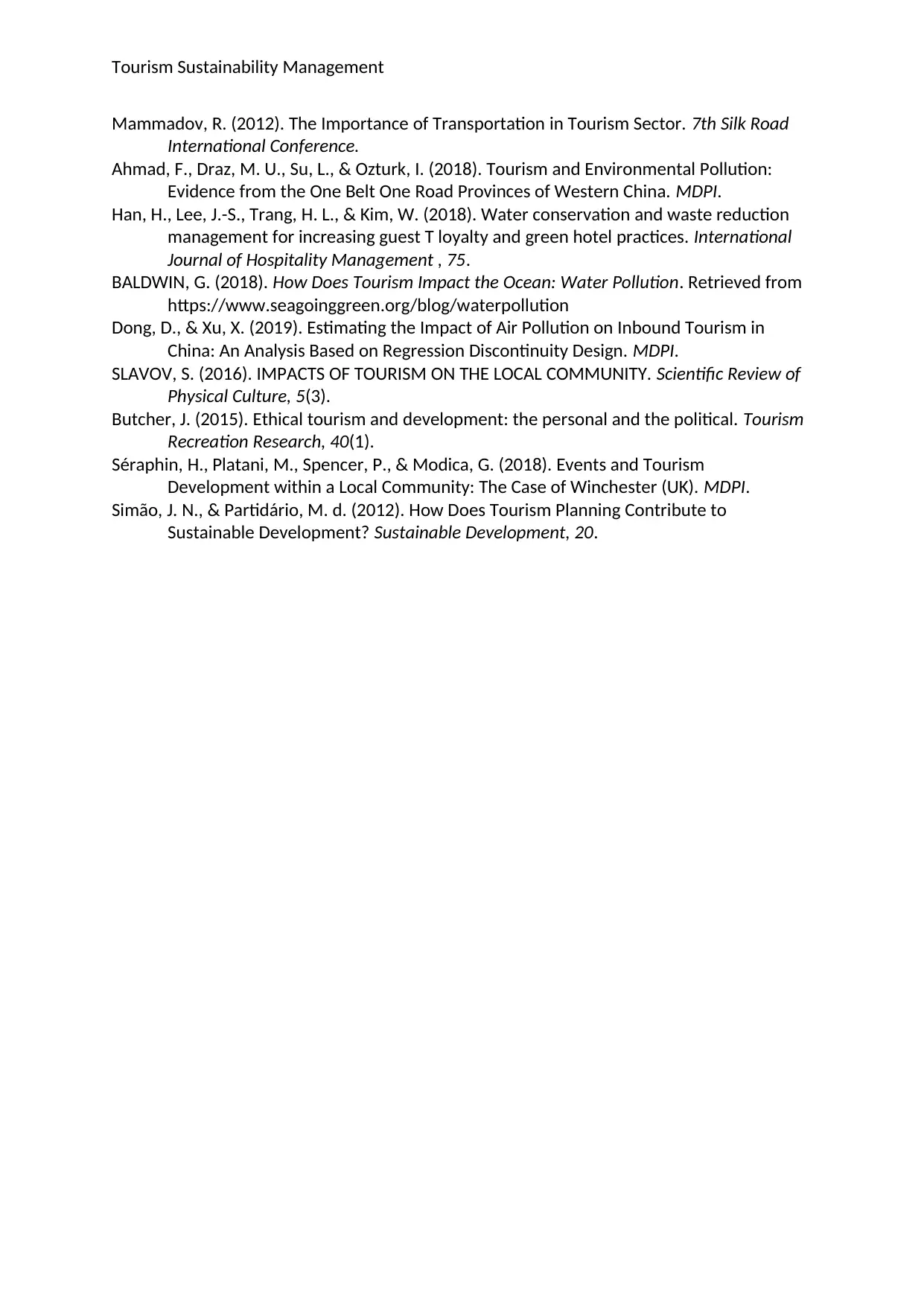
Tourism Sustainability Management
Mammadov, R. (2012). The Importance of Transportation in Tourism Sector. 7th Silk Road
International Conference.
Ahmad, F., Draz, M. U., Su, L., & Ozturk, I. (2018). Tourism and Environmental Pollution:
Evidence from the One Belt One Road Provinces of Western China. MDPI.
Han, H., Lee, J.-S., Trang, H. L., & Kim, W. (2018). Water conservation and waste reduction
management for increasing guest T loyalty and green hotel practices. International
Journal of Hospitality Management , 75.
BALDWIN, G. (2018). How Does Tourism Impact the Ocean: Water Pollution. Retrieved from
https://www.seagoinggreen.org/blog/waterpollution
Dong, D., & Xu, X. (2019). Estimating the Impact of Air Pollution on Inbound Tourism in
China: An Analysis Based on Regression Discontinuity Design. MDPI.
SLAVOV, S. (2016). IMPACTS OF TOURISM ON THE LOCAL COMMUNITY. Scientific Review of
Physical Culture, 5(3).
Butcher, J. (2015). Ethical tourism and development: the personal and the political. Tourism
Recreation Research, 40(1).
Séraphin, H., Platani, M., Spencer, P., & Modica, G. (2018). Events and Tourism
Development within a Local Community: The Case of Winchester (UK). MDPI.
Simão, J. N., & Partidário, M. d. (2012). How Does Tourism Planning Contribute to
Sustainable Development? Sustainable Development, 20.
Mammadov, R. (2012). The Importance of Transportation in Tourism Sector. 7th Silk Road
International Conference.
Ahmad, F., Draz, M. U., Su, L., & Ozturk, I. (2018). Tourism and Environmental Pollution:
Evidence from the One Belt One Road Provinces of Western China. MDPI.
Han, H., Lee, J.-S., Trang, H. L., & Kim, W. (2018). Water conservation and waste reduction
management for increasing guest T loyalty and green hotel practices. International
Journal of Hospitality Management , 75.
BALDWIN, G. (2018). How Does Tourism Impact the Ocean: Water Pollution. Retrieved from
https://www.seagoinggreen.org/blog/waterpollution
Dong, D., & Xu, X. (2019). Estimating the Impact of Air Pollution on Inbound Tourism in
China: An Analysis Based on Regression Discontinuity Design. MDPI.
SLAVOV, S. (2016). IMPACTS OF TOURISM ON THE LOCAL COMMUNITY. Scientific Review of
Physical Culture, 5(3).
Butcher, J. (2015). Ethical tourism and development: the personal and the political. Tourism
Recreation Research, 40(1).
Séraphin, H., Platani, M., Spencer, P., & Modica, G. (2018). Events and Tourism
Development within a Local Community: The Case of Winchester (UK). MDPI.
Simão, J. N., & Partidário, M. d. (2012). How Does Tourism Planning Contribute to
Sustainable Development? Sustainable Development, 20.
⊘ This is a preview!⊘
Do you want full access?
Subscribe today to unlock all pages.

Trusted by 1+ million students worldwide
1 out of 9
Related Documents
Your All-in-One AI-Powered Toolkit for Academic Success.
+13062052269
info@desklib.com
Available 24*7 on WhatsApp / Email
![[object Object]](/_next/static/media/star-bottom.7253800d.svg)
Unlock your academic potential
Copyright © 2020–2025 A2Z Services. All Rights Reserved. Developed and managed by ZUCOL.



![Sustainable and Responsible Tourism Management Report - [Course Name]](/_next/image/?url=https%3A%2F%2Fdesklib.com%2Fmedia%2Fimages%2Ftt%2F97543c1e789843e897460d59424ee454.jpg&w=256&q=75)